Leeds City Tramways
Summary
Leeds introduced Europe's first overhead electric service (Roundhay Electric Tramway) on 29th October 1891, though strictly speaking, it did not officially open to passengers until the following month. The line was owned by Leeds Corporation, but was worked on their behalf by Mr Graff Baker, the agent of the Thompson-Houston Company of the United States. Staff — presumably employees of the Thompson-Houston Company — were issued with uniforms: conductors wore double-breasted jackets with four pairs of buttons, and lapels, whilst motormen appear to have worn single-breasted jackets with five buttons and high, fold-over collars. Whereas the jackets appear to have been devoid of insignia (other than possibly the buttons), the tall kepi-style caps bore a very large semi-circular cap badge, the precise details of which are unknown. The company referred to this badge as a 'front plate', so it was in all likelihood made of pressed metal.
Roundhay Electric Tramway staff were also issued with long, double-breasted overcoats with five pairs of buttons, lapels and high fold-over collars; once again, these do not appear to have carried badges of any kind.
Following the corporation take-over of the Leeds Tramways Company in 1894, staff were required to wear uniforms, excepting those working on the steam tram drivers and stokers, who wore typical railway footplate attire. The corporation initially continued the practice of the erstwhile tramway company in requiring conductors to wear uniforms purchased at their own expense, a policy which was abolished in 1897, the corporation thereafter purchasing and issuing the uniforms.
In 1897, conductors and drivers (with the exception of the steam engine crews) were issued with new double-breasted jackets of blue serge with red piping, bearing five pairs of brass buttons (carrying the municipal device — see link) and high lapels; these were in fact were very similar in style, if not identical to, those worn by staff working the Roundhay electric concession, and likewise, do not appear to have carried any insignia. The caps, which were in a kepi style, did not bear a cap badge. The caps appear to have been changed to a drooping-peak type around 1901, when a brass, shield-shaped cap badge was introduced; this bore system initials ('L.C.T') and a golden fleece, below which was a ribbon containing the grade — either 'DRIVER' or 'CONDUCTOR' — though a version also exists without the ribbon (presumably for other grades of staff). This style of cap badge did not last long, as it was replaced by a completely new pattern at the end of 1902. Although at first glance the new cap badge appeared to be round, it was in fact oval, being slightly taller than broad (see below). The badge comprised a chequered back plate within a wreath, with 'LEEDS' in open-backed letters at the top (beneath a rope), and 'TRAMWAYS' in relief at the bottom — a nickel employee number was mounted in the middle of the badge. The drooping-peak caps upon which these new badges were mounted also bore a wide, corduroy hat band.
The use of an employee number on the cap badge obviated the need to wear licences, the Tramways Committee having taken over the licensing of tramway conductors from Leeds Watch Committee at the end of 1902. Prior to this, conductors had at various times been required to wear a small enamel licence badge or a large brass one.
In 1907, the drooping-peak caps were replaced by a more contemporary peaked design with a tensioned crown (top), the badge remaining unchanged.
The style of the uniform jackets was changed significantly some time before the Great War (possibly as early as 1907), and though still double-breasted, they now had a more functional look to them with high fold-over collars rather than lapels, and were buttoned up to the neck, very probably a concession to the Leeds climate. After the Great War, a return was made to jackets with lapels, still double-breasted, but giving a much smarter appearance than their immediate predecessors. An employee number was now worn on both upper lapels (in individual metal numerals), prefixed with either an 'M' or a 'C' for motorman or conductor.
In 1927, a re-styled uniform — of blue serge with red piping and nickel buttons — was introduced, along with a new cap badge that was quite unlike anything used by any other UK tramway concern (with the possible exception of the nearby Mexborough and Swinton Tramways — see link); this comprised a scallop-topped nickel shield with 'LEEDS' in a blue enamel inlay at the top, and a representation of Leeds prototype Tramcar No 400 in relief underneath. Similar badges were also issued to bus and trolleybus staff, but with the respective vehicles in relief rather than a tram, and enamel inlay of a different colour. After the Second World War, new caps were also introduced; these were very reminiscent of those worn by US Air Force crews, which together with the unusual US Police Department-like cap badge, made for a distinctly American appearance.
A variety of greatcoats appear to have been worn over the years, both double-breasted and single-breasted, and invariably with five buttons (or five pairs of buttons) and high fold-over collars; these did not carry any insignia. In later decades (possibly from the 1930s onwards), a long, double-breasted design was used with four pairs of buttons, lapels and epaulettes; the latter had a button fastening and bore an employee number at the arm end (in individual metal numerals) and a Leeds coat of arms badge in the middle. In all likelihood, the insignia at this time were in chrome.
From late 1907 onwards, tramwaymen with seven years of satisfactory service were awarded a merit stripe and weekly bonus, the former being added to the bearer's left-hand jacket sleeve.
During the Second World War, Leeds, like several other tramway and transport operators, used the services of auxiliary conductors. These individuals were members of the travelling public, who helped the conductor load and unload cars, call out stops and ring signals in exchange for free travel; they wore their own clothing, but were issued with cloth armbands (referred to as brassards) bearing embroidered lettering — 'AUXILIARY L.C.T. CONDUCTOR'— which presumably conferred a degree of authority. The scheme started on the 8th October 1941 and was discontinued on the 11th February 1946, by which time between 1,200 and 1,300 armbands had been issued.
A single photograph of the Roundhay Electric Tramway senior staff member has survived, which almost certainly shows one of the two 'inspectors of motors'. The individual depicted (see below) would appear to be wearing a single-breasted jacket with hidden buttons (or more likely a hook and eye affair), along with a kepi-style cap topped off with a pom pom; the cap carried a badge of unknown pattern, but one which was certainly significantly smaller than those issued to motormen and conductors.
In the early years of corporation operation, inspectors and timekeepers wore elaborate single-breasted jackets closed with a hook and eye arrangement, and stand-up collars; the latter (the left-hand side at least) appears to have borne the grade in embroidered script lettering. Drooping-peak style caps were worn; these had braiding on the peak, as well as an elaborately braided hat band, upon which was a shield-shaped badge, almost certainly cloth with bullion thread, and comprising the arms of Leeds with the bearer's grade in a ribbon underneath. It should be noted that this description of early senior staff uniforms is an extrapolation from a single 'Timekeeper' studio portrait (see below). A single photograph of a senior member of staff taken in 1906 — possibly an inspector — shows the same style of drooping-peak cap and cap badge, but a different style of jacket; the latter is double-breasted with three pairs of plain buttons and lapels.
In later years, inspectors wore single-breasted jackets with a row of five black, cloth-covered buttons, two waist pockets, two breast pockets (with button closures) and lapels; the latter carried the grade on each side in embroidered script lettering. The tensioned-crown peaked caps bore a blue, red and white enamel cap badge in the form of a shield, which itself bore the letters 'L.C.T' and 'INSPECTOR' (within a ribbon). Two varieties are known, representing two distinct periods; the darker one is the earlier of the two, being used up until 1950, and the lighter one thereafter. Inspectors were also issued with overcoats, and in later years gabardine topcoats.
The most senior staff, presumably chief inspectors, wore uniforms based on British Military 'Patrol Jackets', with elaborate braided loops; these existed in both standard and a three-quarter-length versions, the latter presumably serving as an overcoat. Caps were initially of the drooping-peak type, but like all grades, they were eventually superseded by standard tensioned-crown peaked caps. Surviving photographs suggest that they bore large, elaborate cap badges, though precisely what pattern remains unknown.
In common with most tramway systems, Leeds employed women during the Great War to replace male staff lost to the armed services, but only as conductresses, and later on as inspectresses. The first conductresses were taken on in October 1915. Photos indicate that different styles of uniform were worn, though whether this reflected summer/winter wear or a chronology of styles is currently unclear. Both types comprised tailored single-breasted jackets in blue serge with red piping and epaulettes, one having breast pockets (with button fastenings) and high, fold-over collars, the other having hip pockets (with button fastenings), a waist belt (with two buttons) and lapels. A long matching skirt was also initially worn, but these apparently restricted movement, so there were replaced by a divided skirt from August 1916. Given the Leeds weather, heavy single-breasted overcoats were frequently worn, which like the jackets, had high fold-over collars and epaulettes. Headgear took the form of a baggy peaked cap, sometimes referred to as a motor cap; this carried the standard Leeds City Tramways cap badge. Conductresses were awarded a 'Great World War' service badge on the 27th October 1919; the badge was silver and took the form of the Leeds City arms, crested by a blue enamel-inlaid ribbon containing the words 'The Great World War', with a another ribbon below to the left ('L.C.T.') and to the right ('1914 - 1918'). The last ladies were released towards the end of 1919. Inspectresses wore long single-breasted coats with lapels, the collars of which were embroidered with system initials, 'L C T'. Headgear took the form of a baggy peaked cap, very similar to those worn by conductresses, but carrying the standard inspectors' cap badge.
Women were also employed during the Second World War, again only as conductresses, but unlike most urban systems, they were kept on after hostilities ceased, right up until closure of the system. The initial tranche of conductresses started work on the trams on the 19th August 1940; they were issued with blue-serge uniforms comprising a jacket and a divided skirt. Further details are unfortunately unclear, though these uniforms may well have been the same as the garments that are known to have been issued during the later war years and into the 1950s. In this period, conductresses wore a single-breasted tailored jacket with five buttons, a waist belt (with button fastening), lapels and epaulettes; the latter carried an employee number along with another badge of uncertain pattern, though it was probably the Leeds coat of arms badge. A knee-length skirt and/or piped trousers were also provided. Headgear took the form of a stylish baggy cap which carrying the standard Leeds City Tramways shield badge.
For further details of Leeds City Tramways uniforms, see Leeds Transport Volume 2 1902 — 193, pages 699-670; J Soper, Leeds Transport Historical Society (1996).
For a complete history of the system, see 'Leeds Transport Volumes 1 to 4' by J Soper; Leeds Transport Historical Society (1985 to 2007).
Images
Horse tram drivers and conductors
A conductor and a driver pose with an unidentified horsecar outside the Headingley Oak — photo possibly taken around 1900. Photo courtesy of the Tramways and Light Railway Society, with thanks to David Voice.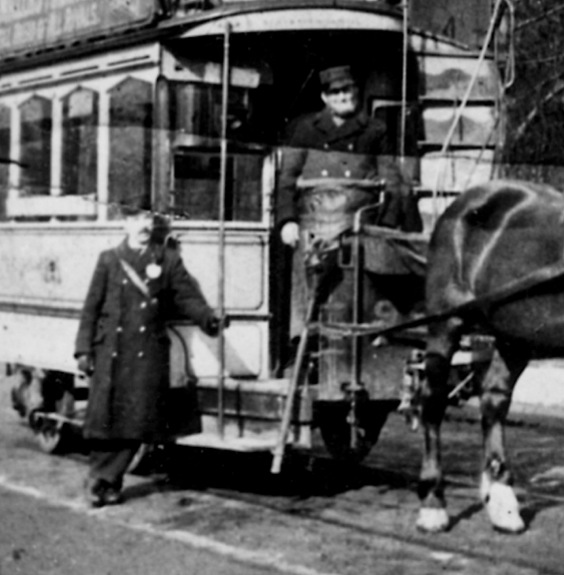
An enlargement of the above graph photograph showing the conductor and the driver. Both men are wearing uniform greatcoats and kepi-style caps, the latter seemingly without insignia. The conductor is wearing a large licence, hanging from his lapel, probably of the type shown below.
Early municipal-era conductor's licence — brass. These licences were issued by Leeds Watch Committee, and appear to have been in use from the mid-1890s through to late 1902, when tramcar staff licensing was dispensed with; they did, however, continue in use with horse bus conductors. The Watch Committee does not appear to have issued this type of licence to electric tram conductors, instead preferring a small lapel badge. Author's Collection.
Steam tram drivers and conductors
Steam Tram No 28 (a Thomas Green product of 1890) and Milnes Trailer No 37 pictured at Wortley — photo probably taken shortly after the municipal take-over (1894), as the trailer still has the company device on the waist panel.
An enlargement of the above photograph showing the driver and conductor, the latter in a jacket with plain buttons, and with a kepi-style cap, seemingly without a badge.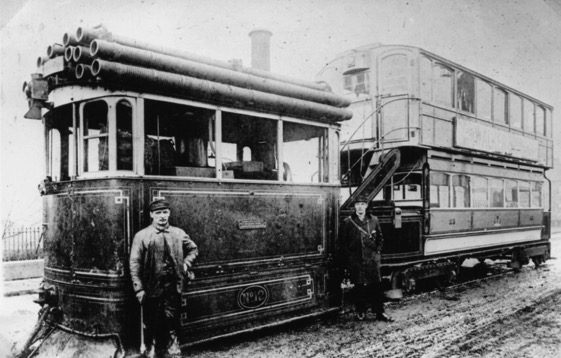
A driver and a conductor pose with Steam Tram No 12 (a Thomas Green product of 1886) and Trailer No 26 (a Milnes product of 1890) at Wortley — photo undated, but definitely taken after the municipal take-over of 1894 as the trailer has the city arms on its waist panel. Photo courtesy of the Tramways and Light Railway Society, with thanks to David Voice.
An enlargement of the above photograph showing the driver, who is wearing typical railway footplate-like attire, and the conductor, who appears to have a self-purchased overcoat and a kepi-style cap, the latter again without a badge.
A conductor and a driver with Thomas Green-built Steam Tram No 30 (delivered in 1897) and Milnes Trailer No 38 at the Meanwood terminus — photo undated, but probably taken around 1899. The conductor is wearing a double-breasted uniform jacket and kepi-style cap, but once again without an obvious badge. Photo courtesy of the Tramways and Light Railway Society, with thanks to David Voice.
Steam Tram No 30 (a Thomas Green product of 1896) and Trailer No 60 pictured at what is believed to be Castleton Bridge in 1900.
An enlargement of the above photograph showing the crew. The conductor is wearing a large, round licence, almost certainly the same pattern as shown above.
Motormen and conductors
A conductor and a motorman pose with a new electric tramcar at the Roundhay Terminus in 1891. Photo from Author's Collection.
An enlargement of the above photograph showing the conductor and the motorman, presumably employees of the Thomson-Houston Company of the United States, which carried out the electrical installation and which also owned the vehicles themselves. The metal cap badge is very large, and of a style favoured by American railroad and streetcar companies. 
Tramcar No 79 outside the depot — photo undated, but almost certainly taken around the time of opening (October/November 1891). Photo courtesy of the Tramways and Light Railway Society, with thanks to David Voice.
A blow-up of the above photograph showing the motorman in more detail.
Tramcar No 77 in Beckett St — photo undated, but certainly taken before the BTHCo withdrew from the lease in 1896, and probably much earlier. Photo courtesy of the Tramways and Light Railway Society, with thanks to David Voice.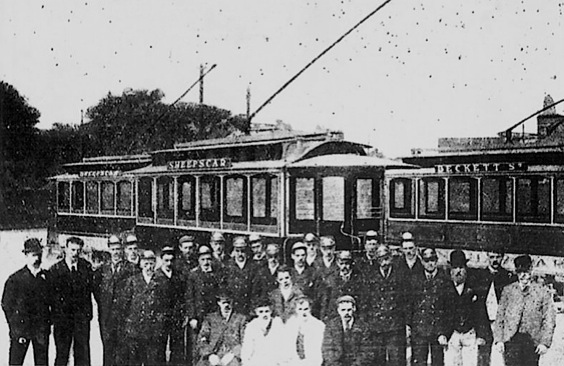
A poor quality, but nevertheless interesting photograph of a large assemblage of Roundhay Electric Tramway employees, possibly the entire operating staff — photo undated, but certainly taken before the municipal take-over. Photo courtesy of the Tramways and Light Railway Society, with thanks to David Voice.
A conductor and a motorman with Tramcar No 147 with a service to Harehills via Beckett St — photo undated, though given that the tram is in pristine condition, it was in all likelihood taken around the time it entered service (15th June 1900). Both men are wearing kepi-style caps, seemingly without insignia, though documentary evidence suggests that they bore a small licence badge issued by Leeds Watch Committee. Although the conductor has what is appears to be a municipal licence on his left breast, this is more than likely a flower or rosette, as no other photo shows electric staff wearing round licences. 
Leeds City Tramways 'DRIVER' cap badge — brass. Photographs indicate that these cap badges were only worn for a very short time, circa 1901/2. Author's Collection.
Leeds City Tramways 'CONDUCTOR' cap badge — brass. Photographs indicate that these cap badges were only worn for a very short time, circa 1901/2. Author's Collection.
1901/2-era cap badge, gradeless — brass. Author's Collection.
A rare early studio portrait of a Leeds City Tramways tramwayman — photo undated, but probably taken in the early Edwardian era.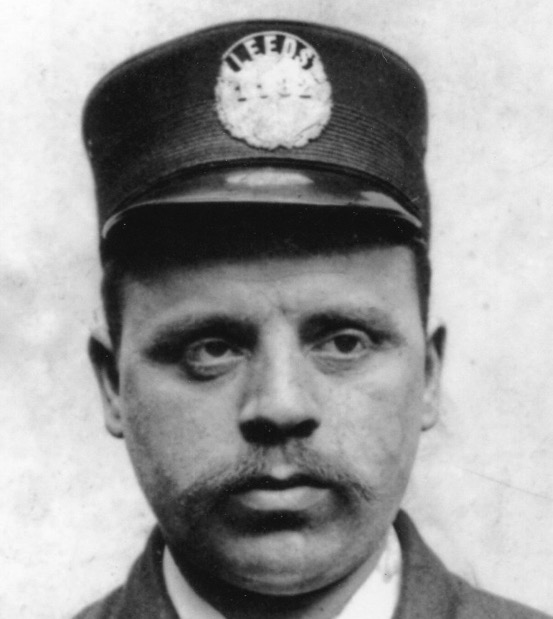
An enlargement of the above photograph showing details of the cap, which is of a drooping-peak type rather than a kepi, with its corduroy hat band and new, elaborate cap badge, in this case No 1182.
Leeds City Tramways cap badge — gilt. These were introduced at the end of 1902, and lasted through to 1927. Author's Collection.
Another enlargement of the above photograph, which reveals the wearer's top left button to actually be a badge. This may possibly be a Watch Committee badge, as tramcar staff were required to be licenced (up until late 1902), at which point it was dispensed with. All licences had, however, to be handed back by Christmas Eve of that year.
1899-built Tramcar No 175 on a service to Beeston — photo undated, but given the pristine condition of the vehicle, probably not all that long after the new route to Beeston was opened in 1901. Although the uniform is unchanged from earlier photos, the motorman is clearly wearing the new cap badge. Photo courtesy of the Tramways and Light Railway Society, with thanks to David Voice.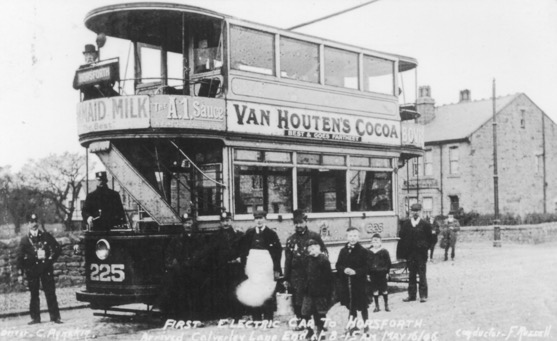
Somewhat of a rarity for a tramway photo, one that is seemingly datable to the minute! This shows the conductor (C Annakin) and motorman (F Russell), as well as two other tramway employees, with the first ever tramcar to Horsforth, at Calverley Lane End. It was apparently taken at 8.15 am on 16th May 1906. All members of staff are wearing drooping-peak caps. Photo courtesy of the Tramways and Light Railway Society, with thanks to David Voice.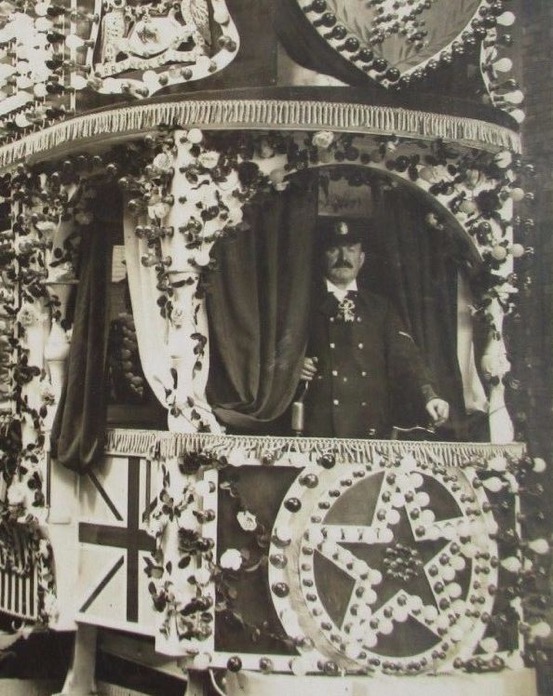
A photo taken in July 1908 to commemorate a royal visit. It is included because it shows the 'merit stripe' on the motorman's left sleeve; these were awarded after seven years' good service (from late 1907 onwards). Author's Collection.
1904-built Brush Tramcar No 37 with crew on a service to New Inn, Wortley — photo undated, but probably taken in the late-Edwardian era. The new tensioned-crown caps, which were introduced in 1907, are clearly in evidence. Both men are wearing long greatcoats, one single-breasted and the other double-breasted. Author's Collection.
A studio portrait of an LCT tramwayman — photo undated, but probably taken shortly before the Great War. New jackets with high, fold-over collars were introduced some time before the Great War, possibly as early as 1907. Author's Collection.
A Leeds crew with Tramcar No 44 (ex Liverpool Corporation Tramways) on a service to the Corn Exchange at Hunslet terminus about 1912. The motorman bears a merit stripe on his left arm. Author's Collection.
A motorman and a conductor pose with Tramcar No 64 — photo undated, but probably taken just before the Great War. Author's Collection.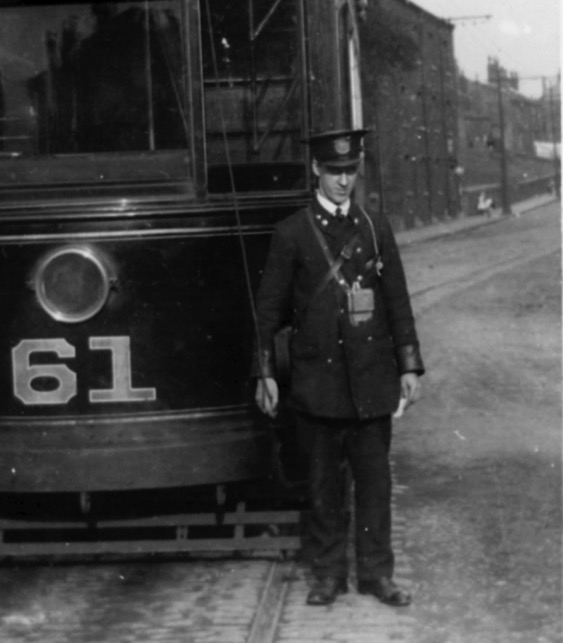
A conductor turning the pole of Tramcar No 61 on a service to Lower Wortley — photo undated, but probably taken in the 1920s. Photo courtesy of the Tramways and Light Railway Society, with thanks to David Voice.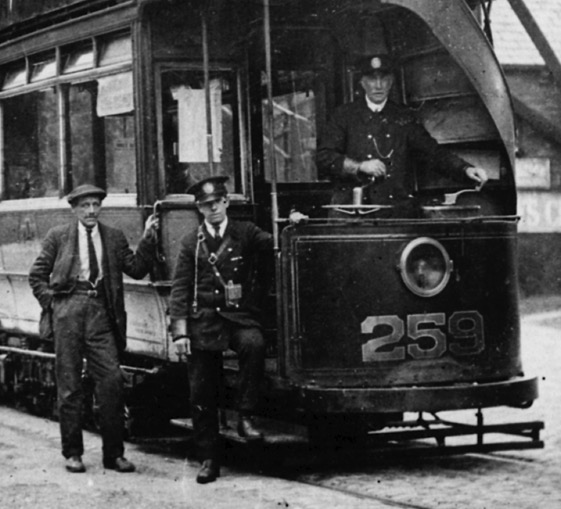
The crew of Tramcar No 259 on a service to Morley — photo undated, but probably taken in the early 1920s. Note the change in the style of the conductor's uniform jacket, which has now reverted to lapels. Photo courtesy of the Tramways and Light Railway Society, with thanks to David Voice.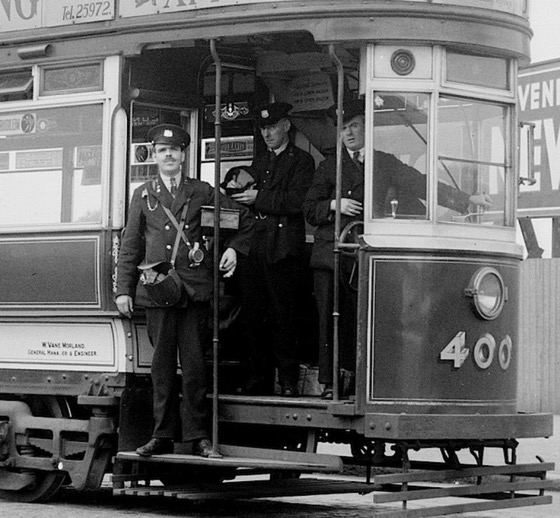
The crew of Tramcar No 400 pose for the camera of H Nicol at the terminus at Guiseley on the 30th September 1933. Note the new shield cap badge, which has a representation of Tramcar No 400 on it. Photo courtesy of the National Tramway Museum. 
Later-period cap badge — nickel. The tram is No 400. Author's Collection.
A motorman, an inspector and a conductor pose for cameraman R B Parr with Tramcar No 602 at Middleton on 11th July 1953. The conductor's cap lacks a tensioning wire, which together with the unusual shield-shaped cap badges confers a distinctly American look and feel. With thanks to the National Tramway Museum. 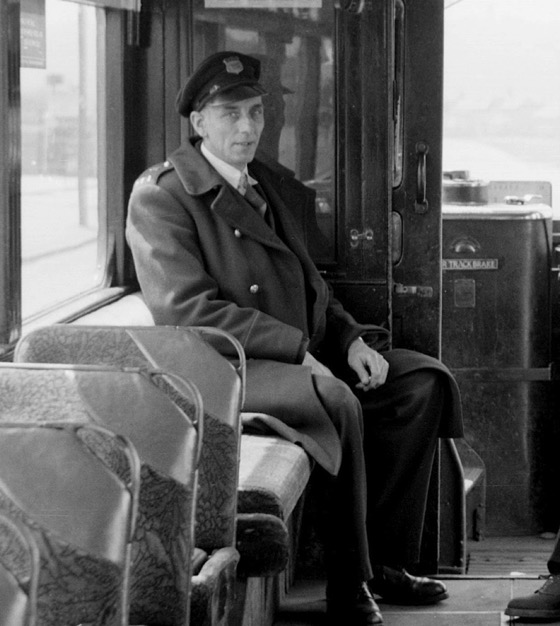
A motorman poses for the camera of M J O'Connor, who fortunately for posterity, often took interior views of the tramcars with their crews. This one was taken in the interior of Tramcar No 277 at Dewsbury Rd on 6th May 1956. The greatcoat epaulettes have an employee number, as well as what appears to be a Leeds coat of arms badge. With thanks to the National Tramway Museum. 
LCT coat of arms greatcoat epaulette badge — chrome — probably issued from the 1940s onwards. Author's Collection.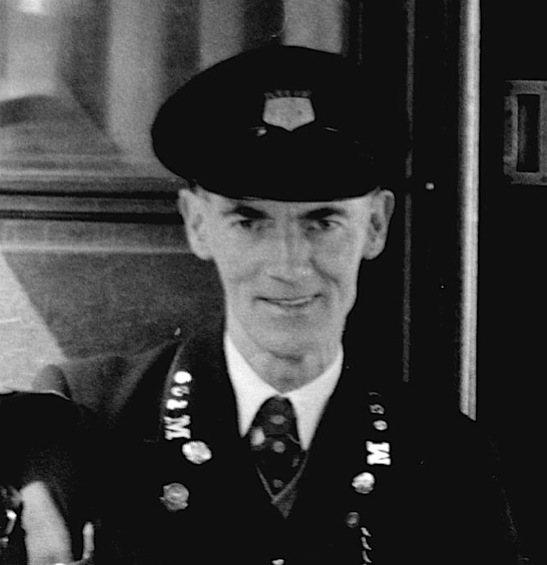
A Leeds City Tramways motorman — 1956. Photo by M J O'Connor, courtesy of the National Tramway Museum. 
A Leeds City Tramways motormen (the individual on the right-hand side is Employee No M378) captured in the depot on the last day of services — 7th November 1959. Photo courtesy of the Stephen Howarth Collection.
A Leeds City Tramways Second World War auxiliary conductor's armband — embroidered yellow lettering on black serge. These were worn by members of the public who volunteered to help regular conductors with their non-revenue duties on darkened and/or overcrowded inner-city trams, usually in exchange for free or reduced travel. Author's Collection.
An LCT 'Learner' badge — yellow and black enamel. It is unclear precisely what this badge was used for, but possibly for motormen and bus drivers. Photo in the public domain.
A brass and blue enamel buttonhole badge issued to school children — from the 21st March 1927 — entitling the holder to travel at a half fare. The badge was initially issued to school children aged between 12 and 18 years of age, as the full adult fare applied from what would now be considered to be the ridiculously low age of 12 years, though it was raised to 14 years around 1928. LEC stands for Leeds Education Committee. With thanks to Billy Haw.
Inspectors
A Thomson-Houston Company electric tramcar with three tramwaymen — photo undated, but probably taken in 1891. Photo in the public domain.
An enlargement of the above photograph showing the figure on the left, who is in all probability an 'inspector of motors'. Although the image is of poor quality, it is good enough to discern the pom pom on the man's cap, as well as the difference in the size and shape of the cap badge, when compared with those issued to motormen and conductors. Additionally, there are no reflections from metallic buttons, suggesting that the buttons were either plain composite, or that the jacket used hook and eye fastenings.
The crew of what is very likely a brand new Tramcar No 6 on the Kirkstall to Roundhay route — photo undated, but probably taken in 1897 when this corporation service was inaugurated. The man on the right is probably an inspector. Photo courtesy of the Tramways and Light Railway Society, with thanks to David Voice.
A superb studio portrait of a Leeds City Tramways timekeeper — photo undated, but probably taken in the early-Edwardian era. Author's Collection.
An enlargement of the above photograph showing details of the collars and the cap. The left-hand collar appears to bear the grade — 'Timekeeper' — in embroidered script lettering. The cap is heavily braided and bears what is probably a cloth badge with bullion thread, with the grade in a ribbon below.
Another accurately dated photograph, this time taken at 5.30am on the 9th July 1906, to commemorate the first service between Leeds and Rodley. The photograph includes six motormen and conductors, as well as a more senior member of staff (foreground, right). Photo courtesy of the Stephen Howarth Collection. 
An enlargement of the above photograph showing the senior member of staff, who is possibly an inspector. Although he is wearing a very similar drooping-peak cap and cap badge to the timekeeper in the photograph above, the jacket is totally different, being double breasted with lapels.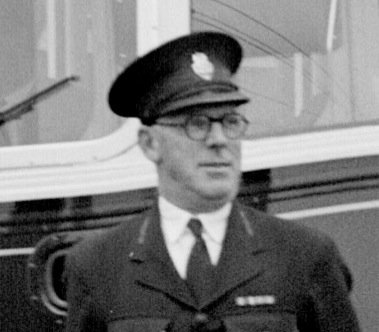
An enlargement of the photograph of Tramcar 602 above (1953), showing details of the inspector's uniform and cap badge.
LCT inspector's cap badge — blue, white & red enamel and nickel. This is believed to be the pattern used up until 1950. Author's Collection.
LCT inspector's cap badge — blue, white & red enamel, and silver/nickel. This is believe to be the pattern used from 1950 onwards. Author's Collection.
A motorman and an inspector pose for photographer M J O'Connor with Tramcar No 209 at the Temple Newsam terminus on 7th May 1958. With thanks to the National Tramway Museum.
Female staff
A studio portrait of Leeds conductresses — photo undated, but almost certainly taken during the Great War, The lady in the middle row, second from left, is wearing a tunic rather than an overcoat, unlike the remainder of the group, Photo courtesy of the Stephen Howarth Collection.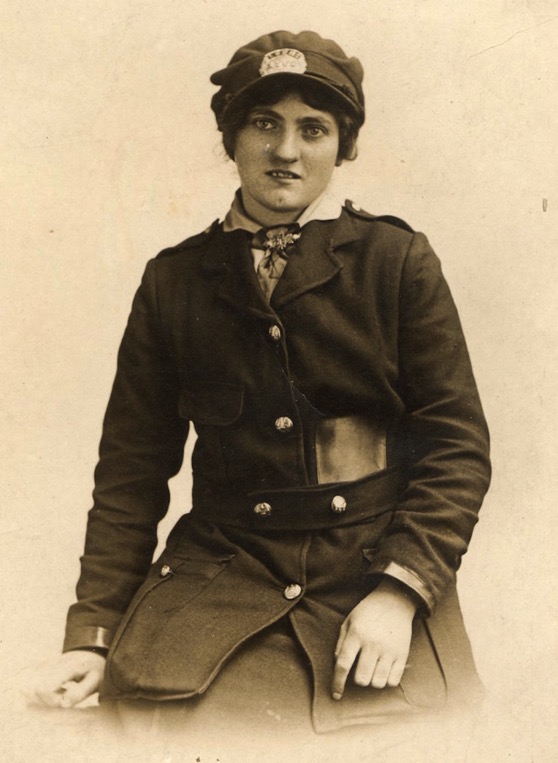
A lovely studio portrait of an LCT Great War tram conductress. The square of leather on the left-side of her jacket was reinforcement, to stop abrasion from the ticket punch (see next photo). Author's Collection.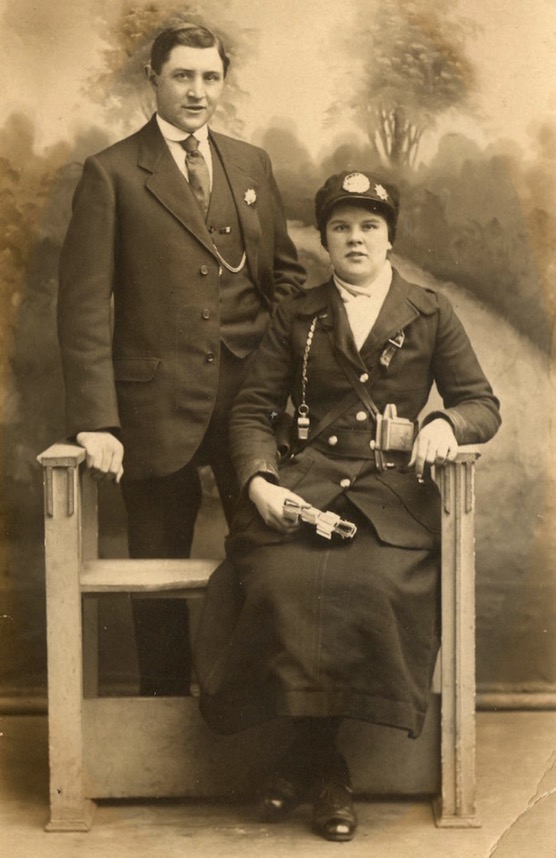
A studio portrait of a Leeds City Tramways Great War conductress and her husband (presumably). Author's Collection.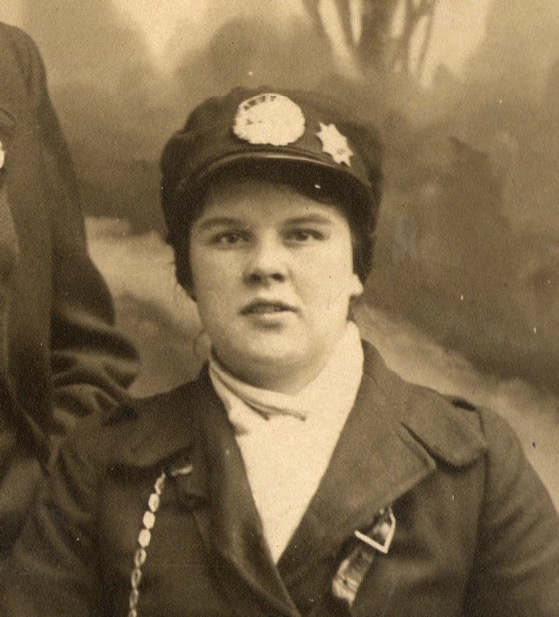
An enlargement of the above photograph showing details of the cap, the standard LCT cap badge, and what is presumably a regimental cap badge (intended to show support for a loved one away with the armed services).
Another studio portrait of an LCT Great War conductress, presumably one living or working in Guiseley. Author's Collection.
A conductress and an inspector (from the shape of the cap badge — see above) on the footstep of Tramcar No 14 - photo undated, but probably taken during or shortly after the Great War. Photo courtesy of the Tramways and Light Railway Society, with thanks to David Voice.
A Great War conductress and a motorman with Tramcar No 339 in 1916, probably at Roundhay. The lady depicted was apparently Leeds' second conductress. Photo courtesy of Adam Smees, the subject's grandson.
A Leeds City Tramways commemorative badge awarded to conductresses after the Great War to thank them for their service — silver and blue enamel.
A rare image of 22 Great War LCT conductresses and two inspectresses, purportedly taken in 1918. Author's Collection.
An enlargement of the above photograph showing the two inspectresses. Their caps carry the standard 'inspector' cap badge.
LCT conductress Joy Walsh — photo undated, but probably taken during or shortly after the Second World War. Author's Collection.
A conductress and a motorman pose for photographer M J O'Connor in Tramcar No 101 at Roundhay Park on 22nd May 1956. With thanks to the National Tramway Museum. 
A Leeds City Tramways conductress — Winifred Twigg — captured for posterity; photo undated, but given the headlamp cover, almost certainly taken during or shortly after the Second World War (my thanks to Paul Haywood for this information). Photo in the public domain.